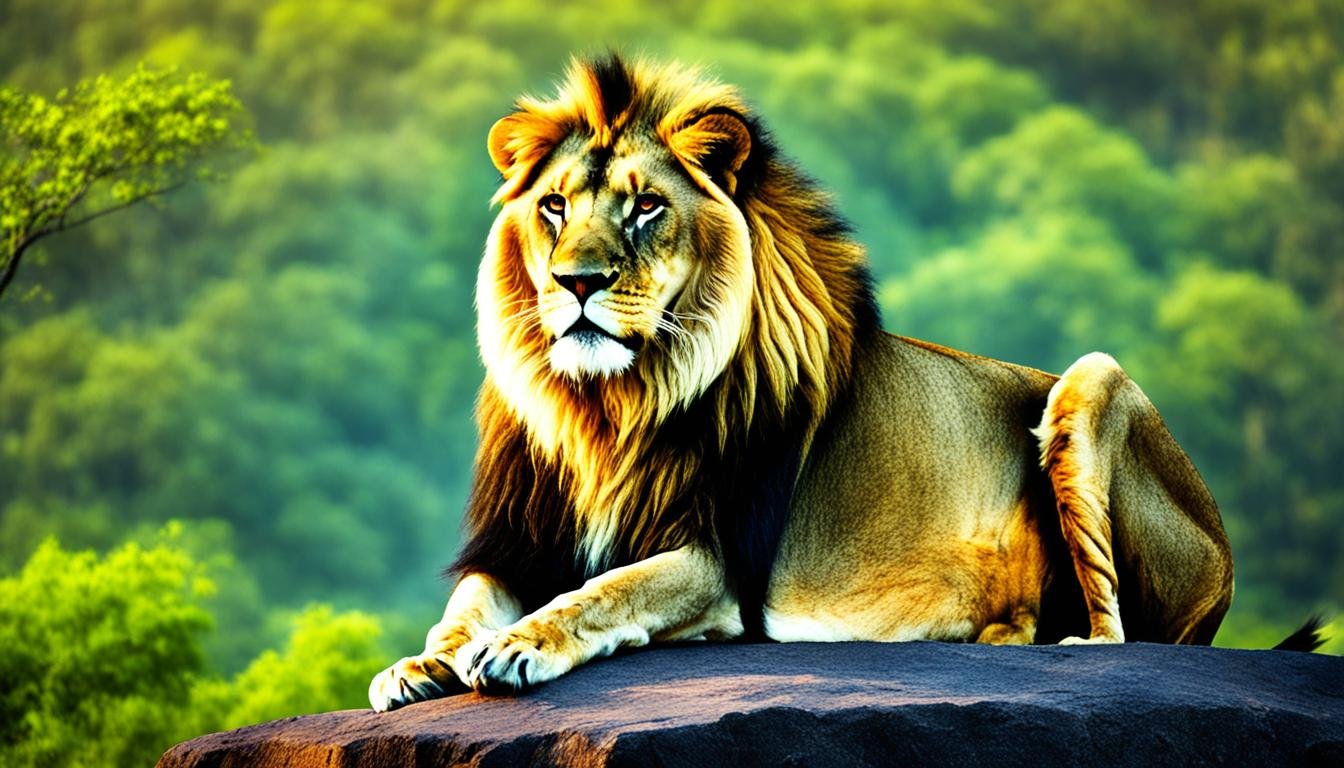The Asiatic lion population faces great danger. These endangered species live only in Gir Forest. This place is a haven of biodiversity. It’s the last home for Asia’s last remaining lions. Conservation efforts are increasing to save them. We discuss, how many Asiatic lions are let in the world.
Asiatic lions once roamed from Greece to India. Now, they only live in Gir’s teak forests in India. Lion conservation includes scientific research, help from local communities, and protecting their habitat. We hope these efforts will allow these majestic lions to thrive.
The Plight of the Asiatic Lion: Current Status and Numbers
The Asiatic lion’s survival is at risk. It lives only in Gujarat, India’s Gir Forest National Park. The current status shows both triumphs and challenges in conservation. The Gir Forest is vital for saving this endangered species.
Endangered, Yet Striving: Understanding the IUCN Classification
The IUCN Red List labels the Asiatic lion as Endangered. Threats include poaching, loss of habitat, and conflicts with humans. Despite this, there are 411 lions in Gir Forest. But, problems like livestock attacks trouble locals and show the tough balance of living with lions.
Gir’s Majestic Inhabitants: Counting the Last Lions of Asia
This lion group is the only one left in the wild. Gir’s conservation work is vital, yet challenges remain. Unlike Southern Africa’s growing lion numbers, Gir’s lions face inbreeding, disease, and habitat issues. Conservation efforts have led to 20 poaching convictions, showing a commitment to protecting these animals.
The fight for the Asiatic lion’s survival highlights a global conservation issue. While lions in Southern Africa are doing better, Gir’s lions are in a unique battle for existence. The global effort and focus on Gir Forest aim to secure a future for these majestic creatures.
Tracing the Roots: Evolution and Historical Range of Asiatic Lions
The Asiatic lion represents both royalty and strength. Its history covers a vast area from Persia to India. Their journey in evolution tells us about their free roam across Asia.
Journey Through Time: The Lion’s Path from Persia to Gir
The Asiatic lion’s story starts in Persia, now Iran. They moved through eastern Turkey into India. Their numbers dropped over time, finding refuge in India’s Gir National Park and Wildlife Sanctuary. Today, around 650 survive under protection there.
Genetic Bottlenecks: Asiatic Lions Vs. Their African Cousins
Asiatic lions, unlike their African relatives, face genetic challenges. This limits their diversity and affects their survival. These concerns are crucial for conservation efforts to save them from extinction.
- Modern lions first appeared in Africa during the Late Pleistocene.
- About 21,000 years ago, some lions left Sub-Saharan Africa, moving to North Africa and Persia.
- Mitochondrial DNA shows different lion subspecies, including the extinct Barbary lion and the endangered Asiatic lion.
The Asiatic lion’s story is one of survival, regional extinction, and urgent protection needs. Their genetic story lives on in Gir National Park, home to the world’s remaining Asiatic lions.
| Characteristic | Asiatic Lion | African Lion |
|---|---|---|
| Adult Male Body Length | 1.8–2.1 m | Varies with subspecies |
| Weight Range (Male) | 170–230 kg | 150–250 kg |
| Habitat | Gir Forest, India | Scattered across Sub-Saharan Africa |
| Conservation Status | Endangered | Ranging from Vulnerable to Critically Endangered (subspecies dependent) |
| Historical Range | Asia: Persia, India | Africa, Historically Europe |
Connecting the past and present shows us a big challenge in saving species. We must keep genetic diversity to protect the Asiatic lion. The story of their past pushes us to prevent their extinction.
How Many Asiatic Lions Are Left in the World
Once found across Palestine, Arabia, Persia, and Northern India, Asiatic lions are now in a critical state. According to the latest count, there are about 674 of them in Gir Forest. This is their only home, showing a rise from the nearly extinct numbers seen in the early 1900s.
Efforts to save them in Gir have made their food sources better. They went from mainly eating domestic cattle to a variety of wild prey. Still, about 40 percent live outside Gir National Park’s safe area. This shows we need to increase their living space to keep them alive.
Gir National Park covers 1,412 square kilometers. But Asiatic lions roam across 12,500-13,000 sq.km. They are barely hanging on. Yet, efforts continue to establish a second safe area for them, as ordered by the Supreme Court.
The story of the Gir lion is one of success in saving a species. The Maldhari tribes and changes in farming have helped lions and humans live together. Even though politics slow their move to Kuno reserve, these lions show how to manage and protect endangered species.
| Year | Population | Location | Dietary Habit (%) | Area Covered (sq.km.) |
|---|---|---|---|---|
| 1936 | 150 | Gir Forest | Livestock: 75 | N/A |
| 1970s | N/A | Gir Forest | Livestock: 75 | N/A |
| 2015 | 523 | Gir Forest | Domestic Cattle: 25 Natural Prey: 75 |
12,500-13,000 |
| Recent Survey | 674 | Gir Forest and beyond | Domestic Cattle: 25 Natural Prey: 75 |
12,500-13,000 |
- Census efforts must continue to provide accurate data for tracking the asiatic lion population and improving conservation strategies.
- Ecological corridors and secondary habitats should be secured to sustain a growing population and to limit human-lion conflict.
- Conservation efforts need strong support from political entities to implement the Indian Supreme Court’s decision affirming the Asiatic lion as a national heritage.
The Unique Traits of Asiatic Lions
The Asiatic lion, found in India, has unique features. These distinguishing features set it apart from African lions. They interest scientists and wildlife lovers for study and conservation.
Mane Contrasts: Comparing Asiatic and African Lions
The mane is a key difference between Asiatic and African lions. The Asiatic lion has a shorter and less dense mane. This makes their face and neck more visible. The mane’s pattern helps with heat release in their hot home.
The Belly Fold: A Distinctive Marker of the Asiatic Subspecies
The Asiatic lion has a unique belly fold. This feature is not found in African lions. It might help in their flexibility and agility.
Research offers insights into the lives of these lions. A 2020 report by the Gujarat Forest Department counted nearly 700 Asiatic lions. This count underlines their delicate status and the need for conservation efforts.
Studies using radio-telemetry have improved our understanding of lion behavior. This helps in creating better strategies for their protection. Coastal lions have larger home ranges than those in Gir protected areas. This shows the challenges in their conservation across different areas.
| Characteristic | Asiatic Lion | African Lion |
|---|---|---|
| Mane | Shorter, less dense | Full, dense |
| Belly Fold | Present | Absent |
| Movement Parameter (σ) | Males: 5.32 km, Females: 2.55 km | Varies |
| Density (lions per 100 km2) | 8.53 (SE 1.05) | Varies |
Asiatic lions have traits that show they are a unique subspecies. These traits are crucial for their survival in the wild. Recognizing and saving these features is vital for their conservation and future prosperity.
Asiatic Lions In The Wild: Threats And Conservation Efforts
The Asiatic lion’s survival is at risk. These lions are a symbol of the Gir Forest’s ecological pride. Their future depends on solving serious threats and improving conservation. It’s crucial to know the dangers they face and how we can help.
Life on the Edge: Risks Facing the Existing Population
Humans and lions often clash, leading to deadly outcomes for these big cats. Research over the years has shown the dangers they face outside protected areas. They live among humans in Gujarat which complicates their survival.
In the Realm of Gir: Conservation Strategies at Work
In Gir Forest, efforts to stop habitat loss are vital. Insights from researchers support local conservation strategies. A recent warning system and studies on lion movements are promising. These efforts aim to grow the lion population from the current 674.
- The population in Gir forest has soared fourfold, signifying successful past conservation strategies.
- Shifting dietary habits, noted by the decline in livestock consumption from 75% in the past to 25% in late 90s, articulate a nuanced coexistence narrative.
- Landscapes within the approximate distribution range of 12,500-13,000 sq.km echo with the roars of a species whose survival script is being rewritten daily.
- Areas like Liliya–Krankach rivet attention as conservation hotspots, housing the largest concentration of Asiatic lions globally in a mere 60 sq.km radius.
Over half of India’s Asiatic lions live outside protected areas. Their coexistence with humans requires constant, creative conservation work.
The Last Stronghold: Gir Forest National Park and Its Precious Inhabitants

Gir Forest National Park is a haven for those who love nature and want to save it. This protected area is not just a simple wildlife sanctuary. It’s the last home for the Asiatic lions. Their risk of extinction is fought with hard work to keep their home safe. Gir is more than just a piece of forest. It shows India’s dedication to keeping its wild animals safe.
The story of these amazing lions is tied to Gir’s protection history. Here, protection has given these lions a chance to live on. With less than 500 left, these Asiatic lions are the heart of Gir. They amaze visitors with their noble look. They also remind us of India’s rich natural world.
Gir is surrounded by dry lands but inside, it’s full of life. It’s a special place for many animals and plants. Let’s learn more about how special this place is:
- Since 1996, the Asiatic lion has been listed as Vulnerable on the IUCN Red List. This shows how important Gir is as a protected area.
- African lions’ numbers dropped by 43% since the early 1990s. But, Asiatic lions have Gir as their safe place.
- In 2017, scientists said there are only two types of lions. This makes Gir’s lions very important for keeping the species going.
- India works hard to protect its animals. Creating protected areas like Gir is key to fighting risks like losing their homes and poaching.
- The Asiatic lion has lost over 90% of its historical home in the last 100 years. Yet, Gir remains a safe spot where they can not just live but thrive.
Gir and its lions show what we can do when we protect nature together. The park is more than a home for lions. It’s a place full of different life forms. Amidst all the stories of loss and hope for the future, Gir stands out. It is home to the Asiatic lions, a symbol of India’s wildlife pride and the undying spirit of nature.
Human-Wildlife Coexistence: Challenges in Asiatic Lion Conservation
Asiatic lion conservation faces the tough challenge of human-wildlife conflict in rural areas. Efforts to promote coexistence are critical, aiming to create peace between homes and wildlife habitats. These efforts work towards securing a future for the Asiatic lion and protecting people’s ways of living.
Safeguarding the Big Cats: Initiatives to Reduce Human-Animal Conflict
Protecting Asiatic lions is crucial as their numbers have dramatically fallen. They now occupy less than 6% of their original habitat. Compared to their African relatives, Asiatic lions need unique conservation efforts for their survival. These efforts include creative and practical strategies to minimize conflict and gain local support.
The Wells of Danger: Preventing Casualties in Rural Landscapes
One key way to reduce conflict is by making rural areas safer for both lions and humans. Installing barriers and early warning systems can prevent accidents and deaths. This approach makes conservation beneficial for everyone, encouraging community support for the lions.
The decline in Asiatic lion numbers is alarming, with significant threats like habitat fragmentation and loss of prey. Since 1994, lion numbers have been cut in half, stressing the need for more funding and community involvement. Reports show a pressing need for increased conservation funds to protect these lions.
Lion pride dynamics suggest new conservation strategies might help. Since lion societies are female-dominated, understanding gender dynamics can improve efforts. Proper funding and effective management give hope for the recovery of Asiatic lions. The Lion Recovery Fund’s significant investment shows a strong commitment to these animals.
The future of Asiatic lion conservation relies on strategic community support to reduce conflicts. With ongoing support and additional resources, we can create a world where these majestic lions thrive among us. This goal benefits both humans and lions, promoting a balanced ecosystem.
Asiatic Lions Outside Their Sanctuary: Migratory Patterns and New Habitats
Asiatic lions are now moving beyond Gujarat’s Gir Forest. This is due to their growing numbers, from about 700 in 2020 to more lions along the coast. They are in search of new places to call home. Their spread shows how well they can adapt and why we need conservation corridors.
Searching for Space: Asiatic Lions Dispersing Beyond Gir’s Borders
Lions are naturally inclined to find larger living areas, especially those by the coast who need more space than the Gir forest offers. Research from 2019 to 2021 involved tracking 10 lions with GPS radio collars. This research is crucial for creating new homes for them and easing Gir’s burden.
Conservation Corridors: Facilitating Safe Passage for the Roaming Prides
A new reserve in Gujarat’s Barda wildlife sanctuary has been proposed for the lions. There’s also talk of revisiting relocation plans. This shows how our methods to help the lions are changing. Efforts are being made to protect their migration paths and include safety measures in new developments. These corridors are vital. They provide a safe way for lions to move, which is essential since the world’s lion population has dropped by 43% in the last 20 years.
Zoos and Their Role in Preserving Asiatic Lions

Zoos from London to Gujarat’s Sakkarbaug play a vital role in saving the Asiatic lion. They offer a safe space for these great animals, away from dangers in the wild. Their breeding programs do more than continue the species.
They keep the lion’s genetic health strong. This is key for their survival and bringing more diversity.
Lions of London Zoo: An International Effort in Asiatic Lion Conservation
The London Zoo works hard to save the Asiatic lion. They provide a safe place for these lions, helping protect a species close to vanishing. This effort is crucial, especially with the Gir Forest’s ecosystem at risk.
Genetic Reservoirs: Breeding Programs and Their Role in Species Survival
Breeding programs, like those for Asiatic lions, are crucial. They aim to keep the lions genetically healthy. This helps in bringing them back to the wild and fighting diseases.
| Location | Asiatic Lion Population | Conservation Status | Initiatives |
|---|---|---|---|
| Gir Forest, Western India | Approximately 600 lions | Last remaining natural habitat | SMART patrolling, forest ranger dedication, Liontrust partnership |
| Sakkarbaug Zoo, Gujarat | Nearly 50 lions | Important breeding population | Breeding programs, disease management training |
| London Zoo | Part of breeding programme | Back-up population efforts | International breeding cooperation |
Zoos are crucial for saving the Asiatic lion. The Gir Forest is their main home but effort goes beyond. It includes breeding and education worldwide.
In India and the UK, zoos work to ensure the lion’s roar isn’t lost. By keeping strong genes, future generations might still see these majestic animals.
Conclusion
The global lion population is at a critical point, with numbers ranging from 25,000 to 40,000. The Serengeti Lion Project, which has a detailed database on over 5,000 lions, emphasizes the importance of scientific research for their survival. However, the data also shows that without essential resources like river confluence, some lion prides reproduce less, leading to their decline.
The way we see lion conservation has drastically changed in the last 30 years. The thought of lions being endangered seemed unbelievable back then. Now, there’s an urgent need to list lions as endangered, putting them on the same level as tigers and snow leopards. This change shows how critical it is to not just recognize but actively protect lions and their habitats.
Conservation efforts for lions must press on strongly, blending policy advocacy, science, and community efforts. It’s key to treat lions as critically endangered to ensure their safety. Through public awareness and global teamwork, we can hope for a future where lions still rule the savanna. Their roars symbolizing conservation triumph, not the silence of extinction.
FAQ
What is the current population of Asiatic lions worldwide?
It’s hard to say exactly how many Asiatic lions are left. But it’s believed there are around 600 in India’s Gir Forest.
Why are Asiatic lions considered an endangered species?
Asiatic lions are endangered because they have a very low population. They face threats like losing their home, fighting with humans, and not having enough variation in their genes.
Where can I find the last remaining Asiatic lions?
The last Asiatic lions live in India’s Gir Forest in Gujarat.
What is the difference between Asiatic lions and their African counterparts?
Asiatic lions’ manes are shorter and less full than African lions’. They also have a skin fold on their belly that African lions don’t have.
What are the major threats to Asiatic lions in the wild?
The top dangers they face are losing their habitats, conflicts with people, being poached, and having limited genetic diversity.
How are conservation efforts being made to protect Asiatic lions?
Efforts to protect them include fixing up their habitat, involving the community, and actions to reduce conflicts between humans and lions.
Where can I visit Asiatic lions in their natural habitat?
You can see them in their natural environment at the Gir Forest National Park, their last stronghold.
How do communities coexist with Asiatic lions in the Gir Forest?
Living with Asiatic lions is tough, but efforts are being made. This includes getting the community involved, educating people, and taking steps to prevent conflict.
Do Asiatic lions migrate to new habitats beyond the Gir Forest?
Yes, Asiatic lions are moving beyond the Gir Forest. They’re looking for new places to live because of their growing numbers and not enough space.
What is the role of zoos in preserving Asiatic lions?
Zoos are important for keeping the lions’ genetic diversity. The Asiatic lions at London Zoo are part of a big effort to save them.
How can I contribute to the conservation of Asiatic lions?
You can help by spreading the word, giving to wildlife groups, and supporting eco-friendly tourism in the lions’ home areas.













